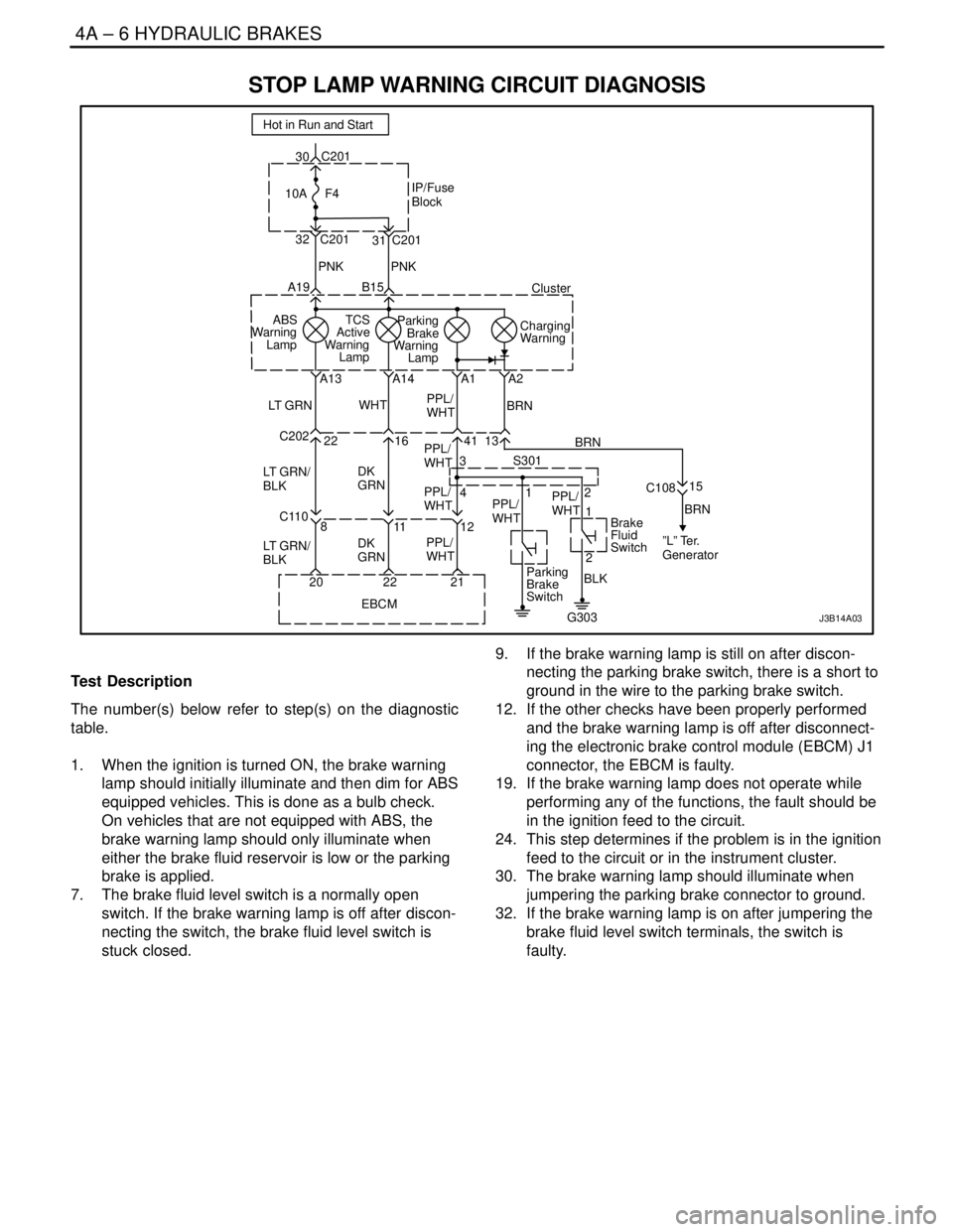2004 DAEWOO LACETTI fuse brake stop
[x] Cancel search: fuse brake stopPage 328 of 2643

1F – 82IENGINE CONTROLS
DAEWOO V–121 BL4
IDLE AIR CONTROL SYSTEM CHECK (1.8L DOHC)
Circuit Description
The Engine Control Module (ECM) controls the engine idle
speed with the Idle Air Control (IAC) valve. To increase the
idle speed, the ECM pulls the IAC pintle away from its seat,
allowing more air to pass by the throttle body. To decrease
the idle speed, it extends the IAC valve pintle toward its
seat, reducing bypass air flow. A scan tool will read the
ECM commands to the IAC valve in counts. The higher
counts indicate more air bypass (higher idle). The lower
counts indicate less air is allowed to bypass (lower idle).
Diagnostic Aids
If the idle is too high, stop the engine. Fully extend the Idle
Air Control (IAC) valve with a IAC driver. Start the engine.
If the idle speed is above 800 rpm, locate and repair the
vacuum leak. Also, check for a binding throttle plate or
throttle linkage or an incorrect base idle setting.
Test Description
The number(s) below refer to step(s) on the diagnostic
table.
2. The IAC valve is extended and retracted by the IAC
driver. IAC valve movement is verified by an engine
speed change. If no change in engine speed oc-
curs, the valve can be removed from the throttle
body and tested. Connect the IAC driver to the re-
moved IAC valve and turn the ignition ON. Do not
start the engine.5. This step checks the quality of the IAC valve move-
ment in Step 2. Fully extending the IAC valve may
cause an engine stall. This may be normal.
6. Steps 2 and 5 verify proper IAC valve operation.
This step checks the IAC circuit for a wiring or ECM
fault.
Idle Air Control Valve Reset Procedure
Whenever the battery cable or the Engine Control Module
(ECM) connector or the ECM fuse Ef11 is disconnected or
replaced, the following idle learn procedure must be per-
formed:
1. Turn the ignition ON for 5 seconds.
2. Turn the ignition OFF for 10 seconds.
3. Turn the ignition ON for 5 seconds.
4. Start the engine in park/neutral.
5. Allow the engine to run until the engine coolant is
above 185°F (85°C).
6. Turn the A/C ON for 10 seconds, if equipped.
7. Turn the A/C OFF for 10 seconds, if equipped.
8. If the vehicle is equipped with an automatic trans-
axle, apply the parking brake. While pressing the
brake pedal, place the transaxle in D (drive).
9. Turn the A/C ON for 10 seconds, if equipped.
10. Turn the A/C OFF for 10 seconds, if equipped.
11. Turn the ignition OFF. The idle learn procedure is
complete.
Page 1022 of 2643

4A – 6IHYDRAULIC BRAKES
DAEWOO V–121 BL4
STOP LAMP WARNING CIRCUIT DIAGNOSIS
J3B14A03
10A30
F4
32
A19
A13 A14 A1 A2B15 C201
31C201IP/Fuse
Block C201
C202
C110C108 S301 WHT
BRN
BRN
Parking
Brake
SwitchBrake
Fluid
Switch
BLKBRN LT GRN
DK
GRN
DK
GRN LT GRN/
BLK
LT GRN/
BLKPPL/
WHT
PPL/
WHT
PPL/
WHTPPL/
WHT PPL/
WHT
PPL/
WHT ABS
Warning
Lamp TCS
Active
Warning
Lamp Parking
Brake
Warning
Lamp Charging
Warning
Hot in Run and Start
PNK
Cluster PNK
EBCM”L” Ter.
Generator 1 12
2
20 2222 16 41 13
3
4
11 1 215
8
21
G303
Test Description
The number(s) below refer to step(s) on the diagnostic
table.
1. When the ignition is turned ON, the brake warning
lamp should initially illuminate and then dim for ABS
equipped vehicles. This is done as a bulb check.
On vehicles that are not equipped with ABS, the
brake warning lamp should only illuminate when
either the brake fluid reservoir is low or the parking
brake is applied.
7. The brake fluid level switch is a normally open
switch. If the brake warning lamp is off after discon-
necting the switch, the brake fluid level switch is
stuck closed.9. If the brake warning lamp is still on after discon-
necting the parking brake switch, there is a short to
ground in the wire to the parking brake switch.
12. If the other checks have been properly performed
and the brake warning lamp is off after disconnect-
ing the electronic brake control module (EBCM) J1
connector, the EBCM is faulty.
19. If the brake warning lamp does not operate while
performing any of the functions, the fault should be
in the ignition feed to the circuit.
24. This step determines if the problem is in the ignition
feed to the circuit or in the instrument cluster.
30. The brake warning lamp should illuminate when
jumpering the parking brake connector to ground.
32. If the brake warning lamp is on after jumpering the
brake fluid level switch terminals, the switch is
faulty.
Page 1129 of 2643

4F – 48IANTILOCK BRAKE SYSTEM
DAEWOO V–121 BL4
DTC C0161 – ABS Brake Switch Circuit Malfunction
StepActionValue(s)YesNo
1Step on the brake pedal.
Do the brake lights come on at all?–Go to Step 3Go to Step 2
2Remove your foot from the brake pedal.
Do the lights stay on continuously?–Go to Step 8Go to Step 11
3Check fuse EF13 in the engine compartment fuse
block.
Is fuse EF13 blown?–Go to Step 4Go to Step 6
41. Replace fuse EF13.
2. Check the new fuse.
Does the new fuse blow?–Go to Step 5Go to Step 7
51. Repair the short to ground in the brake light
circuitry.
2. Install a new fuse EF13.
Is the repair complete?–System OK–
6Repair the open in the brake light switch circuit ORN/
BLK from terminal 6 of connector C102 at the engine
fuse block to the brake light switch and circuit LT
BLU from terminal 11 of splice S301.
Is the repair complete?–System OK–
7Check for functioning of the brake lights and the ABS
system.
Is the repair complete?–System OK–
8Check the brake light switch on the brake pedal.
Is the switch faulty?–Go to Step 9Go to Step 10
9Repair the brake light switch.
Is the repair complete?–System OK–
10Repair the short to positive in the circuit YEL be-
tween the brake light switch, splice S301, the brake
lights, the center high–mounted stoplamp, and the
ABS wiring harness connector at the EBCM terminal
14.
Is the repair complete?–System OK–
111. Disconnect the EBCM connector.
2. Use a digital voltmeter (DVM) to measure volt-
age between pins 14 and 19 of the ABS har-
ness connector at the EBCM.
3. Have an assistant step on the brake pedal.
Does the DVM indicate the specified value?11–14 vGo to Step 13Go to Step 12
Page 1152 of 2643

ANTILOCK BRAKE SYSTEM 4F – 71
DAEWOO V–121 BL4
TIRES AND ABS/EBD
Replacement Tires
Tire size is important for proper performance of the ABS
system. Replacement tires should be the same size, load
range, and construction as the original tires. Replace tires
in axle sets and only with tires of the same tire perfor-
mance criteria (TPC) specification number. Use of any
other size or type may seriously affect the ABS operation.
TIRES AND ABS/EBD
Notice : There is no serviceable or removable EEPROM.
The EBCM must be replaced as an assembly.
The EBCM is attached to the hydraulic unit in the engine
compartment. The controlling element of ABS 5.3 is a mi-
croprocessor–based EBCM. Inputs to the system include
the four wheel speed sensors, the stoplamp switch, the
ignition switch, and the unswitched battery voltage. There
is an output to a bi–directional serial data link, located in
pin K of Data Link Connector (DLC) for service diagnostic
tools and assembly plant testing.
The EBCM monitors the speed of each wheel. If any wheel
begins to approach lockup and the brake switch is closed
(brake pedal depressed), the EBCM controls the sole-
noids to reduce brake pressure to the wheel approaching
lockup. Once the wheel regains traction, brake pressure
is increased until the wheel again begins to approach lock-
up. This cycle repeats until either the vehicle comes to a
stop, the brake pedal is released, or no wheels approach
lockup.
Additionally, the EBCM monitors itself, each input (except
the serial data link), and each output for proper operation.
If it detects any system malfunction, the EBCM will store
a DTC in nonvolatile memory (EEPROM) (DTCs will not
disappear if the battery is disconnected). Refer to ”Self
Diagnostics” in this section for more detailed information.
FRONT WHEEL SPEED SENSOR
The front wheel speed sensors are of a variable reluctance
type. Each sensor is attached to the steering knuckle,
close to a toothed ring. The result, as teeth pass by the
sensor, is an AC voltage with a frequency proportional to
the speed of the wheel. The magnitude of the voltage and
frequency increase with increasing speed. The sensor is
not repairable, nor is the air gap adjustable.
FRONT WHEEL SPEED SENSOR
RINGS
The toothed ring mentioned above is pressed onto the
wheel–side (outer) constant velocity joint. Each ring con-
tains 47 equally spaced teeth. Exercise care during ser-
vice procedures to avoid prying or contacting this ring. Ex-cessive contact may cause damage to one or more teeth.
If the ring is damaged, the wheel–side constant velocity
joint must be replaced.
REAR WHEEL SPEED SENSOR AND
RINGS
The rear wheel speed sensors operate in the same man-
ner as the front wheel speed sensors. They incorporate a
length of flexible harness with the connector attached to
the end of the harness. The rear wheel speed rings are in-
corporated into the hub assemblies and cannot be re-
placed separately, but require replacement of the rear
hub/bearing assembly.
VALUE RELAY AND PUMP MOTOR
RELAY
The valve relay and the motor pump relay are located in-
side the electronic brake control module (EBCM) and are
not replaceable. If one should fail, replace the EBCM.
WIRING HARNESS
The wiring harness is the mechanism by which the elec-
tronic brake control module (EBCM) is electrically con-
nected to power and to ground, to the wheel speed sen-
sors, the fuses, the switches, the indicators, and the serial
communications port. The components, considered part
of the wiring harness, are the wires that provide electrical
interconnection, and connectors (terminals, pins, con-
tacts, or lugs) that provide an electrical/mechanical inter-
face from the wire to a system component.
INDICATORS
The electronic brake control module (EBCM) continuously
monitors itself and the other ABS components. If the
EBCM detects a problem with the system, the amber ABS
indicator will light continuously to alert the driver to the
problem. An illuminated ABS indicator indicates that the
ABS system has detected a problem that affects the op-
eration of ABS. No antilock braking will be available. Nor-
mal, non–antilock brake performance will remain. In order
to regain ABS braking ability, the ABS must be serviced.
The red BRAKE indicator will be illuminated when the sys-
tem detects a low brake fluid level in the master cylinder
or when the parking brake switch is closed (the parking
brake is engaged) or EBD system is diabled.
WARNING : EBD INDICATOR LAMP WIRING IS CON-
NECTED TO THE PARKING BRAKE LAMP. IF THE
PARKING BRAKE LAMP IS TURNED ON WHEN YOU
DRIVING, CHECKING ON WHETHER THE PARKING
BRAKE LEVER IS ENAGED OR THE BRAKE FLUID
LEVEL IS LOW. IF THE SYSTEM HAS NO PROBLEM,
THE EBD SYSTEM IS WORKING IMPROPERLY. THE
EBD SYSTEM MUST BE SERVICED.
Page 1398 of 2643

ZF 4 HP 16 AUTOMATIC TRANSAXLE 5A1 – 49
DAEWOO V–121 BL4
Functional Check Procedure
Inspect
1. Install a tachometer or scan tool.
2. Operate the vehicle unit proper operating tempera-
ture is reached.
3. Drive the vehicle at 80 to 88km/h (50 to 55 mph)
with light throttle(road load).
4. Maintaining throttle position, lightly touch the brake
pedal and check for release of the TCC and a slight
increase in engine speed(rpm).
5. Release the brake slowly accelerate and check for
a reapply of the Lock up clutch and a slight de-
crease in engine speed(rpm).
Torque Converter Evaluation
Torque Converter Stator
The torque converter stator roller clutch can have one of
two different type malfunctions :
A. Stator assembly freewheels in both directions.
B. Stator assembly remains Locked up at all times.
Condition A – Poor Acceleration Low
Speed
The car tends to have poor acceleration from a stand still.
At speeds above 50 to 55km/h(30 to 35mph), the car may
act normal. If poor acceleration is noted, it should first be
determined that the exhaust system is not blocked, and
the transaxle is in 1st(First) gear when starting out.
If the engine freely accelerates to high rpm in N(Neutral),
it can be assumed that the engine and exhaust system are
normal. Checking for poor performance in ”Drive” and ”Re-
verse” will help determine if the stator is freewheeling at all
times.
Condition B – Poor Acceleration High
Speed
Engine rpm and car speed limited or restricted at high
speeds. Performance when accelerating from a standstill
is normal. Engine may overheat. Visual examination of the
converter may reveal a blue color from overheating.
If the converter has been removed, the stator roller clutch
can be checked by inserting two fingers into the splined in-
ner race of the roller clutch and trying to turn freely clock-
wise, but not turn or be very difficult to turn counter clock-
wise.
Noise
Torque converter whine is usually noticed when the ve-
hicle is stopped and the transaxle is in ”Drive” or ”Re-
verse”. The noise will increase when engine rpm is in-
creased. The noise will stop when the vehicle is moving or
when the torque converter clutch is applied because both
halves of the converter are turning at the same speed.
Perform a stall test to make sure the noise is actually com-
ing from the converter :1. Place foot on brake.
2. Put gear selector in ”Drive”.
3. Depress accelerator to approximately 1200rpm for
no more than six seconds.
Notice : If the accelerator is depressed for more than six
seconds, damage to the transaxle may occur.
A torque converter noise will increase under this load.
Important : This noise should not be confused with pump
whine noise which is usually noticeable in P (Park), N
(Neutral) and all other gear ranges. Pump whine will vary
with pressure ranges.
The torque converter should be replaced under any of the
following conditions:
S External leaks in the hub weld area.
S Converter hub is scored or damaged.
S Converter pilot is broken, damaged or fits poorly
into crankshaft.
S Steel particles are found after flushing the cooler
and cooler lines.
S Pump is damaged or steel particles are found in the
converter.
S Vehicle has TCC shudder and/or no TCC apply.
Replace only after all hydraulic and electrical diag-
noses have been made.(Lock up clutch material
may be glazed.)
S Converter has an imbalance which cannot be cor–
rected. (Refer To Converter Vibration Test Proce-
dure.)
S Converter is contaminated with engine coolant con-
taining antifreeze.
S Internal failure of stator roller clutch.
S Excess end play.
S Heavy clutch debris due to overheating (blue con-
verter).
S Steel particles or clutch lining material found in fluid
filter or on magnet when no internal parts in unit are
worn or damaged(indicates that lining material
came from converter).
The torque converter should not be replace if :
S The oil has an odor, is discolored, and there is no
evidence of metal or clutch facing particles.
S The threads in one or more of the converter bolt
holes are damaged.
–correct with thread insert.
S Transaxle failure did not display evidence of dam-
age or worn internal parts, steel particles or clutch
plate lining material in unit and inside the fluid filter.
S Vehicle has been exposed to high mileage(only).
The exception may be where the Lock up clutch
damper plate lining has seen excess wear by ve-
hicles operated in heavy and/or constant traffic,
such as taxi, delivery or police use.
Lock–Up Clutch Shudder Diagnosis
The key to diagnosing lock–up clutch(TCC) shudder is to
note when it happens and under what conditions.
Page 2250 of 2643

9B – 24ILIGHTING SYSTEMS
DAEWOO V–121 BL4
Stoplamps Do Not Work
Notice : When probing a bulb socket with a voltmeter or a test lamp, do not contact the side of the socket (ground) when
you are testing the positive contact at the bottom of the socket. If the voltage and the ground are both available at the bulb
socket, contacting both at the same time with a test probe will cause a blown fuse.
Step
ActionValue(s)YesNo
1Check fuse Ef13.
Is fuse Ef13 blown?–Go to Step 2Go to Step 3
21. Check for a short circuit and repair it, if neces-
sary.
2. Replace the fuse.
Is the repair complete?–System OK–
3Use a voltmeter to check the voltage at fuse Ef13.
Is the voltage at Ef13 equal to the specified value?11–14 vGo to Step 5Go to Step 4
4Repair the power supply circuit for fuse Ef13.
Is the repair complete?–System OK–
51. Press the brake pedal.
2. Check the positive terminals of the bulb sock-
ets with a test lamp.
Does the test lamp illuminate?–Go to Step 6Go to Step 8
6Connect an ohmmeter between ground and the sto-
plamp ground terminal.
Is the resistance equal to the specified value?0 WGo to Step 8Go to Step 7
7Repair the ground circuit.
Is the repair complete?–System OK–
81. Disconnect the wiring connector from the brake
switch.
2. Press the brake pedal.
3. Use an ohmmeter to check continuity between
terminals 2 and 4.
Is the resistance equal to the specified value?0 WGo to Step 10Go to Step 9
9Replace the brake switch.
Is the repair complete?–System OK–
101. Disconnect the brake switch electrical connec-
tor.
2. Check the voltage at terminal 2.
Does the voltmeter show the specified value?11–14 vGo to Step 12Go to Step 11
11Repair the open circuit between the fuse Ef13 and
the brake switch.
Is the repair complete?–System OK–
12Repair the open circuit between the brake switch
and the stoplamps.
Is the repair complete?–System OK–
Page 2272 of 2643

9B – 46ILITHING SYSTEMS
DAEWOO V–121 BL4
GENERAL DESCRIPTION
AND SYSTEM OPERATION
HEADLAMPS–ON REMINDER CHIME
When the headlamp switch is in the headlamps–on or
parking lamps–on position, voltage is applied to the chime
module. When the ignition is in ON, ACC or START, volt-
age is applied through the fuse block to the module. These
two voltages are sensed, and the chime module is not
sounded.
When the ignition is not in ON, ACC or START, the module
loses voltage. The chime module senses change. If the
voltage is still available, it is applied to sound the chime.
The chime can be turned off by turning the headlamp
switch off. The module no longer senses voltage from the
headlamp switch, so the chime module does not sound.
HEADLAMPS
The headlamps are controlled by the multifunction lever
located on the left side of the steering column. They will
come on with the ignition switch in any position. Turning
the headlamp switch to the first position turns on the park-
ing lamps, the license plate lamps and the instrument pan-
el illumination. Turning the switch to the second position
turns on all of the previous lamps and the headlamps.
Turning the switch to the OFF position turns off all the
lamps.
Headlamp high beams and low beams are also controlled
by this lever. When the headlamps are on, pushing the le-
ver away from the driver until the switch clicks changes the
lamp from low beam to high beam. An indicator lamp on
the instrument cluster assembly will come on when the
high beam headlamps are on. To return the headlamps to
low beam, pull the lever toward the driver.
The headlamps must be aimed for proper illumination of
the road. Headlamp aim should be checked whenever a
new headlamp assembly is installed, or whenever service
repairs to the front end area may have disturbed the head-
lamp assembly or its mountings.
DAYTIME RUNNING LAMPS
The Daytime Running Lamps (DRL) will come on when:
S The ignition is ON.
S The light is OFF.
S The parking brake is released.
When the exterior lights are on, the DRL will turn off. To
turn the DRL off when idling, apply the parking brake.
PARKING AND TURN SIGNAL LAMPS
The parking lamps can be turned on by turning the lighting
switch to the first position. The parking lamps can be
turned off by turning the switch to the OFF position.When the turn signals are activated, the front and rear turn
signal lamps flash to signal a turn. The turn signals work
only when the ignition is ON.
The turn signals are controlled by the light switch on the
left side of the steering column. Moving the lever all the
way up or down (past the detent) will turn on the front and
rear turn signals. When the turn is completed, the lever will
return to horizontal and the turn signals will stop flashing.
For changing lanes, or for shallow turns in which the steer-
ing wheel does not turn far enough to cancel the signal,
move the signal lever only to the first detent and hold it
there. When the lever is released, it will return to horizontal
and the turn signals will cancel.
FOG LAMPS
The fog lamp switch is on the instrument panel to the right
of the steering column. To use the fog lamps, first turn on
the headlamps or the parking lamps. Then push the fog
lamp switch. The indicator light in the switch will illuminate
to indicate that the fog lamps are on. Push the switch again
to turn off the fog lamps. The indicator light will then go off.
The fog lamps should not be used as a substitute for the
headlamps.
The fog lamps must be aimed for proper illumination of the
road. Fog lamp aim should be checked when a new bulb
is installed or if service or repairs in the front end area may
have disturbed the fog lamp mountings.
REAR COMBINATION LAMPS
The taillamps, stoplamps, turn signal lamps and backup
lamp are one assembly.
Turning on either the headlamps or the parking lamps will
also turn on the taillamps. When the brake pedal is
pushed, the taillamps will glow brighter to serve as sto-
plamps.
The center high–mounted stoplamp is located in the rear
window and will come on when the brake pedal is pressed.
LICENSE PLATE LAMP
The license plate lamps will come on when the headlamps
or the parking lamps are on. The license plate lamps are
mounted above the license plate.
INTERIOR COURTESY LAMP
The courtesy lamp is located on the headliner just behind
the front seats. The lamp switch has three positions. If the
switch is left in the center position, the lamp will go on
whenever a door is opened and go off when it is closed.
In the ON position, the lamp will stay on until it is turned off.
In the OFF position, the lamp will not come on, even when
a door is opened.
LUGGAGE COMPARTMENT LAMP
The luggage compartment lamp is located under the deck
lid sill plate on the notchback. The lamp is located on the
left–side wheelhouse trim panel on the hatchback. It will
come on whenever the luggage compartment is opened.